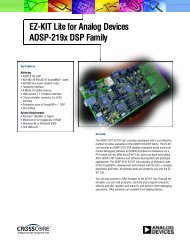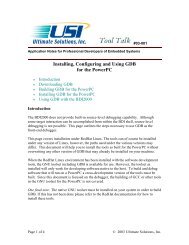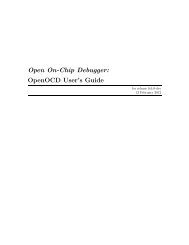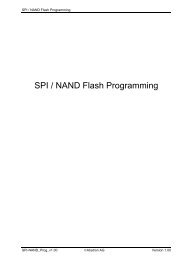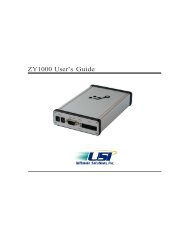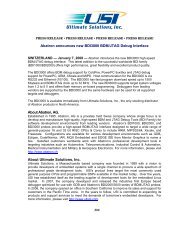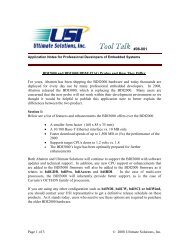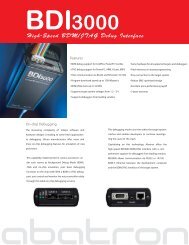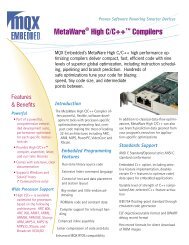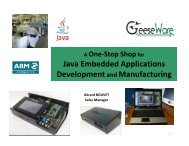STM32 Journal - Digikey
STM32 Journal - Digikey
STM32 Journal - Digikey
You also want an ePaper? Increase the reach of your titles
YUMPU automatically turns print PDFs into web optimized ePapers that Google loves.
<strong>STM32</strong> <strong>Journal</strong><br />
sets can be larger than a single<br />
page and there are no longer<br />
“far” addressing penalties.<br />
The use of object-oriented<br />
constructs, as is common with<br />
modern programming and<br />
modeling tools, can also be<br />
implemented without disruptive<br />
fragmentation.<br />
Without question, the best<br />
compiler is the human brain.<br />
Given enough time, a person<br />
can create a highly optimized<br />
program that no compiler can<br />
beat. Programming in assembly<br />
can also be more efficient than a<br />
C version of the same program.<br />
Time, however, is one of the<br />
resources of which developers<br />
don’t have a surplus. In addition,<br />
hand-written code can be<br />
extremely fragile; if the product<br />
specs change in a material<br />
way, many of a programmer’s<br />
optimizations will need to be<br />
completely reevaluated.<br />
The reality is that Keil’s MDK-<br />
ARM and IAR Embedded<br />
Workbench are smart enough<br />
to make excellent coding<br />
choices that might take a<br />
person weeks to evaluate. For<br />
example, how data is laid out<br />
impacts performance. There’s<br />
also the challenge of balancing<br />
optimization techniques like<br />
loop unrolling to memory<br />
footprint. A compiler can make<br />
these decisions for an entire<br />
program in just minutes. Each<br />
of these tools offers numerous<br />
optimization options it can<br />
perform automatically for the<br />
<strong>STM32</strong> F0 architecture that are<br />
significantly different than those<br />
typical with 8- and 16-bit MCUs.<br />
These options include data-flow<br />
optimizations such as common<br />
sub-expression elimination and<br />
loop optimizations such as loop<br />
combining and distribution.<br />
They also include advanced<br />
techniques like branch<br />
speculation and executing code<br />
out of sequence.<br />
These development tools for<br />
the <strong>STM32</strong> F0 give excellent<br />
results. Compiler efficiency<br />
compared to human coding<br />
has been estimated at 97%.<br />
Put another way, the cost of<br />
achieving that last 3% is on the<br />
order of weeks to months of<br />
development time. In addition,<br />
if a major design change<br />
is required, the compiler<br />
can complete a new set of<br />
optimizations with just a simple<br />
recompile.<br />
As a modern architecture, the<br />
<strong>STM32</strong> F0 is supported by<br />
similarly modern tools that<br />
utilize the latest advancements<br />
in compiler, debugger, and<br />
middleware technology to<br />
reduce development time and<br />
effort considerably. Being based<br />
on the Cortex-M architecture,<br />
the <strong>STM32</strong> F0 is backed by a<br />
larger ecosystem of tools and<br />
production-ready software than<br />
any other MCU architecture on<br />
the market. In addition, for many<br />
applications where the code<br />
base is small, the tools may be<br />
effectively free. For example,<br />
both IAR Embedded Workbench<br />
and Keil’s MDK-ARM are<br />
free when used for programs<br />
under 32 KB, thus enabling<br />
32-bit design with a low initial<br />
investment.<br />
Advanced Debugging<br />
While the ability to design<br />
demanding applications quickly<br />
is important, developers need<br />
debugging capabilities that<br />
can abstract the complexity of<br />
applications while still providing<br />
full visibility and control during<br />
run-time operation. In addition,<br />
many embedded markets,<br />
including medical and industrial,<br />
require that application software<br />
be certified as well.<br />
The integrated debug<br />
capabilities of the <strong>STM32</strong><br />
F0 provide many advanced<br />
capabilities that offer a superior<br />
debug experience compared<br />
to old-fashioned 8- and 16-bit<br />
architectures. For example, the<br />
<strong>STM32</strong> F0 architecture features<br />
ARM’s Coresight technology<br />
to help developers analyze,<br />
optimize, and verify program<br />
execution with minimal effort<br />
and cost.<br />
Coresight represents the<br />
latest in advanced debugging<br />
technology. Traditional MCUs<br />
offer only limited run/stop debug<br />
capabilities. To achieve greater<br />
visibility, an in-circuit emulator<br />
on the order of $1000s may be<br />
required, and a different pod will<br />
be required for each MCU in use.<br />
A few of the benefits Coresight<br />
provides which other MCU<br />
architectures do not include<br />
on-the-fly read/write access<br />
and trace capabilities at the<br />
instruction, data, and application<br />
level. As implemented in the<br />
<strong>STM32</strong> F0, Coresight also<br />
supports up to 4 hardware<br />
breakpoints and 2 watchpoints<br />
without requiring the use of<br />
intrusive monitoring techniques<br />
that can skew performance.<br />
Developers also have a choice<br />
of many low-cost debug<br />
adapters for the <strong>STM32</strong> F0. For<br />
example, the STLink in-circuit<br />
7




